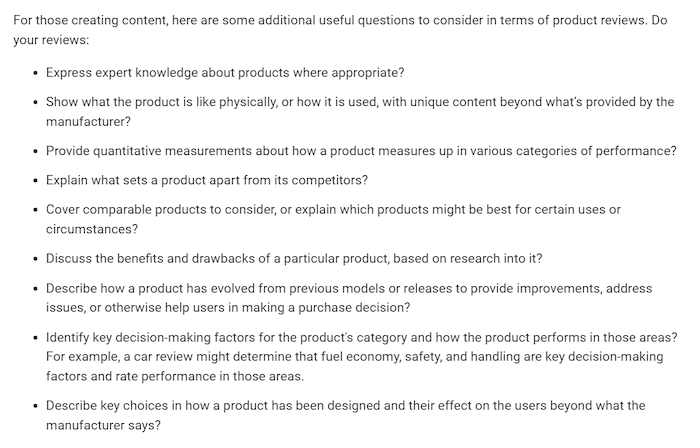
Google is constantly updating its algorithm to ensure users get the best search results.
From the Panda update in 2011 to ongoing core updates in 2021, the search engine constantly introduces changes to ensure the most helpful content appears at the top of the page.
Following this approach, Google has introduced yet another update—this time focused on product reviews.
Now, everyone who’s been shopping online for a while knows product reviews are extremely important.
A Trustpilot study shows 9 out of 10 users prefer reading product reviews before shopping online. In fact, a BrightLocal study shows nearly 80 percent of users trust online product reviews as much as they value personal product recommendations from friends and family.
While product reviews are popular in general, a Bizrate Insights study shows Google is the most popular channel for finding product reviews.
This means, if you have an ecommerce site or work on publishing product reviews on Google, you need to pay attention to Google’s product review update for the best results.
Confused about what Google’s product review update is and where to get started?
Don’t worry; it’s not as complicated as it sounds.
What’s New With Google’s Product Review Update?
Announced on Google’s Search Central Blog, Google’s product review update is aimed at rewarding users publishing the most helpful reviews first, whether or not they are positive overall.
In a nutshell, this means Google will display in-depth, informative product reviews at the top of search results while “thin content that simply summarizes a bunch of products” will appear at the bottom.
For instance, product reviews that focus on product specifications, discuss how it helps, and include pros and cons of the item might be prioritized more than product reviews that only talk about how “good” or “bad” the product is.
The idea behind this decision is to ensure users are getting trustworthy advice, minus the fluff.
So now, instead of having to scroll through hundreds of low-quality reviews, users can directly read specific, informative, and detailed reviews to make the right shopping decisions.
This update is currently limited to English-language reviews, but it may soon expand to other languages as well. Therefore, if you’re in the ecommerce industry, it’s better to be prepared.
You may have to rethink your product review strategy.
What Do Ecommerce Sites Need to Know About Google’s Product Review Update?
If you are an ecommerce site owner, a content creator, or an SEO specialist, I have good news for you.
Google has directly provided a list of questions you should focus on answering to ensure you’re uploading high-quality product reviews that are an excellent match to Google’s product review update.

The new guidelines show the search engine is more interested in providing high-quality information to users, making the recent Google product review update an extension of that goal.
Potential Impact of Google’s Product Review Update
If you run an affiliate website, the Google product review update means you have to focus on publishing more in-depth reviews that offer detailed information about the product beyond what the manufacturer says.
This will help your content rank higher and attract traffic organically. Don’t take this update for granted.
On the other hand, if your affiliate site is full of surface-level product reviews that only list the features without adding new information, you’re at risk of being negatively impacted by the new update.
If this happens, all is not lost. There are ways to recover from the Google algorithm penalty.
However, affiliate website owners aren’t the only ones who should be concerned about the Google product review update.
Along with affiliate content creators and website owners, this Google product review update is also important for ecommerce businesses.
Think about it this way: if your affiliate sites post low-quality product reviews, you’ll lose traffic and miss out on sales.
As an ecommerce business owner, you have to make sure the reviews of your products are informative and detailed to rank higher on search engines.
5 Tips for High-Quality Product Reviews
If the Google product review update sounds like a lot of work so far, don’t let the changes scare you.
There’s an interesting silver lining here.
Along with this update, Google has offered a lot of guidelines to help you adapt your content strategy to ensure your product reviews are ranking higher.
To help you even more, I’ve outlined a list of five strategies for creating high-quality product reviews, so your content appears first and draws plenty of organic traffic. This way, you’re helping your audience make better buying decisions while also finding new readers organically.
Ready to level up your product review game?
Here are the best tips, tricks, and strategies with actionable steps to improve the quality of your product reviews to be in line with Google’s product review update.
1. Provide Visuals of the Product
Take a moment, and ask yourself this question: What would you prefer when you’re buying a new product? Would you want to read long descriptions of how the product works, or would you like to see someone use the product?
Most people prefer option 2. They want to see the product in action and see what it looks like from different angles.
Studies show visual information like a photograph is remembered 65 percent more than plain text. You can also see this in action on social media sites like Facebook where visual content receives 352 percent more engagement than posts with only text.
Google noticed this and now prioritizes product reviews that include “evidence of products being tested.”
Hard to imagine what a visual product review looks like?
Here’s an example of a product review with real visuals by Tom’s Guide, a tech product review site.

Honest feedback can truly help shape consumer decisions, so Google is now urging affiliate sites and other product review publishers to offer real reviews with visual evidence of the product being tested.
This means your product reviews will rank higher if they include real images, videos, and other “evidence” content proving you have actually tried the product (with possible penalties for stock photos).
2. Provide Multiple Links to Purchase From
Wouldn’t it be nice to have options when buying a product online?
What if you love a product but don’t want to buy it from Amazon?
Wouldn’t you be more likely to make the purchase if you have different buying options?
It’s true. Online shopping is more convenient when you have multiple product varieties and sellers to choose from.
That’s why Google’s product review update will now prioritize product reviews that offer “links to multiple sellers to give the reader the option to purchase from their merchant of choice.”
Say you’re writing an affiliate post on Samsung tablets. Instead of offering just an Amazon link to buy the product, include links to the official Samsung website, BestBuy, eBay, and other retailers so the user has many options to choose from.
The best part? This doesn’t require you to go out of your way. You can just add multiple affiliate links on the same page, right next to each other.
Here’s an example from Digital Trends showing how you can add multiple retailer links to your product reviews.

3. Write With the User in Mind
When you’re shopping online and reading product reviews, what do you look for?
You look for details about the product, and particularly about how other buyers have experienced the item.
This can include questions like: Did it break easily? Does the color fade over time? Does it pair well with other items?
This is the kind of information most users are looking for in product reviews. If you want to publish genuinely helpful, high-quality product reviews, make sure you’re including this information in your content.
Doing this will position you as an authoritative source and an expert in your industry. This has the potential to increase reader loyalty and eventually boost your conversion rate.
Remember, not only are you helping your readers make the best shopping decisions but you’re also positioning yourself as a leader in the field. It’s a win-win situation.
4. Explain How the Product Is Better Than Competitors’
Sometimes reading about the product in a review isn’t enough. Say I want to buy a tablet but I’m confused between Samsung and Apple. What will I do? I’ll search for articles highlighting the differences between the two.
This is where product comparison reviews shine. If your product review is explaining how one item is better than the competitors’, you’re more likely to help the consumer make the decision.
Here is an example of a comparison product review posted on the Chicago Tribune.

The new Google product review update is prioritizing such reviews that offer information comparing competitor products. Ultimately, if you want to rank higher, try to explain how product X is better (or worse) than what the competitor has to offer.
5. Include More Details Than the Manufacturer
Consumers often turn to product reviews because they want more information than what the manufacturer has to offer. When you want your reviews to be helpful, make sure you’re providing something new. These should be details the consumer can’t find on the manufacturer or retailer website.
Some examples of extra details include answering:
- How does the product feel in your hand?
- How long does the product last?
- Where does it break/tear/fade?
- What are the real difficulties in using the product?
- What are the unexpected benefits of using the product?
Frequently Asked Questions About Google’s Product Review Update
Who does the Google product review update impact?
The Google product review update particularly impacts affiliate websites and blogs as their content is highly focused on product reviews. The new changes also impact ecommerce business owners as most people depend on product reviews to make online shopping decisions.
How to improve product reviews to match the Google product review update?
If you want to improve your product reviews so they’re in line with Google’s product review update, make sure the reviews are detailed, offer photos and videos to show testing evidence, provide links to multiple retailers, and write the reviews with user concerns in mind.
What should I include in my product reviews to make them helpful?
Writing product reviews with user concerns in mind can make them more helpful. Here, you may include extra details about the product that the manufacturer and retailer websites don’t offer. For example, informative reviews can discuss the product’s durability, weaknesses, versatility, and other details the seller may not have offered.
What to avoid when writing product reviews to rank higher in search results?
If you want your product reviews to rank higher in Google search results, avoid writing fluff reviews. Skip the salesy language and get to the point.
Don’t ramble about unnecessary details and definitely don’t repeat the same information available on the manufacturer and retailer website. Instead, try to offer helpful details that will help consumers make the right buying decision.
Google’s Product Review Update Conclusion
Google frequently introduces changes to its algorithm to offer the best search experience to its users. The latest product review update focuses on prioritizing genuinely helpful reviews.
Affiliate site owners and ecommerce businesses should take special note of these changes as their business model may depend on product reviews.
Use the strategies I’ve outlined in this post to help you write and publish in-depth, informative, substantial product reviews that rank higher and drive organic traffic.
How will you improve your product reviews to stay in line with Google’s product review update?
from Blog – Neil Patel https://ift.tt/3JCOB4e
via IFTTT
No comments:
Post a Comment